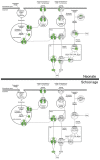The influence of developmental age on the early transcriptomic response of children with septic shock
- PMID: 21738952
- PMCID: PMC3321808
- DOI: 10.2119/molmed.2011.00169
The influence of developmental age on the early transcriptomic response of children with septic shock
Abstract
Septic shock is a frequent and costly problem among patients in the pediatric intensive care unit (PICU) and is associated with high mortality and devastating survivor morbidity. Genome-wide expression patterns can provide molecular granularity of the host response and offer insight into why large variations in outcomes exist. We derived whole-blood genome-wide expression patterns within 24 h of PICU admission from children with septic shock. We compared the transcriptome between septic shock developmental-age groups defined as neonates (≤ 28 d, n = 17), infants (1 month to 1 year, n = 62), toddlers (2-5 years, n = 54) and school-age (≥ 6 years, n = 47) and age-matched controls. Direct intergroup comparisons demonstrated profound changes in neonates, relative to older children. Neonates with septic shock demonstrated reduced expression of genes representing key pathways of innate and adaptive immunity. In contrast to the largely upregulated transcriptome in all other groups, neonates exhibited a predominantly downregulated transcriptome when compared with controls. Neonates and school-age subjects had the most uniquely regulated genes relative to controls. Age-specific studies of the host response are necessary to identify developmentally relevant translational opportunities that may lead to improved sepsis outcomes.
Figures






References
-
- Watson RS, Carcillo JA. Scope and epidemiology of pediatric sepsis. Pediatr Crit Care Med. 2005;6:S3–5. - PubMed
-
- Mathews TJ, MacDorman MF. Infant mortality statistics from the 2005 period linked birth/infant death data set. Natl Vital Stat Rep. 2008;57:1–32. - PubMed
-
- Lawn JE, Cousens S, Zupan J. 4 million neonatal deaths: when? where? why? Lancet. 2005;365:891–900. - PubMed
-
- Checchia PA, et al. Myocardial transcriptional profiles in a murine model of sepsis: evidence for the importance of age. Pediatr Crit Care Med. 2008;9:530–5. - PubMed
Publication types
MeSH terms
Substances
Grants and funding
LinkOut - more resources
Full Text Sources
Other Literature Sources
Medical
Molecular Biology Databases

